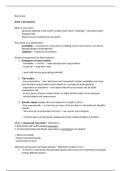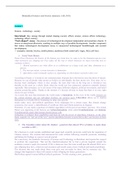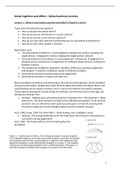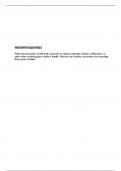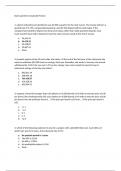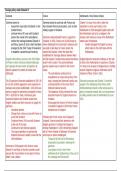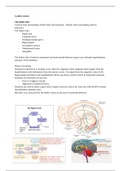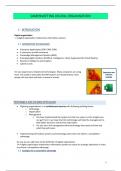What divides America’s two main parties?
- In America the term liberalism refers more to modern liberalism (i.e. welfare state, govt
intervention), whereas in most of Europe liberalism usually refers to classical liberalism
(limited govt, laissez faire); American liberalism involves:
- Economy: big govt, higher taxes, greater regulation, welfare programs
- Social issues: civil rights, abortion rights, gay marriage, gun control
- Conservatism in America:
- Economy: small govt, low taxes, limited regulation, limited welfare state
- Social issues: ‘traditional’ values, anti-abortion/gay marriage/immigration
Big tent/catch-all parties = party that seeks to attract voters with a wide range of political views; may
have multiple factions/ideologies within the party
- Geographical divide in America:
- Northern states & urban areas tend to be more liberal
- Southern states & rural areas tend to be more conservative
- Civil rights legislation is associated with Democrats but a bigger proportion of
Republicans (80%) in Congress supported the 1964 Civil Rights Act than
congressional Democrats (64%): this was because 90% of lawmakers from states
that stayed in the union during the Civil War supported it vs. 7% of lawmakers from
states that were in the Confederacy (so liberal Democrats in the north supported it,
conservative Democrats in the south didn’t)
- America is often referred to as a two-party political system but Polsby argues it is
more like a ‘100 party system’ because there are variations in the political cultures of
every single state which create ‘considerable differences overall in what it means to
be, or to vote, Democratic of Republican’ e.g. the Texas Democratic Party will
probably prioritise different issues to the NY Democratic Party because these states
have very different cultures & demographics (who value/think different things)
- Polls now show people are far more likely to characterise Democrats as the liberal party &
Republicans as the conservative party (previously quite evenly split):
- Both parties have changed in response to crises & adopted more clearly
liberal/conservative stances: Great Depression (Republicans took classical liberal
approach & wanted to allow the economy to recover on its own, Democrats took
modern liberal approach & thought govt should stimulate the economy & provide
welfare support; shifted the label of ‘Big Govt’ to the Democrats), Democrats’ ‘Great
Society’ approach in the 1960s (party became more fiscally/socially liberal: Medicare,
Medicaid, Civil Rights, desegregation; these changes were too much for the party’s
more conservative supporters in the south who then gravitated towards the
Republicans), Southern Strategy & ‘Reaganomics’ (party became more
fiscally/socially conservative: supported ‘states’ rights’, tax cuts, spending cuts,
supporting prayer in schools, opposing affirmative action)
, How conservative was President George W. Bush?
- Bush originally appeared to be a fiscal conservative e.g. cutting income tax in 2001,
property/investment tax in 2003 (both changes benefited wealthy Americans the most)
- But his policies also greatly increased the size & spending of the federal govt e.g.
Medicare expansion (Medicare Modernisation Act 2003: expanded coverage for
elderly Americans to include prescription drug costs; largest expansion to Medicare
since its creation in 1975), education policy (No Child Left Behind At 2001: to receive
new federal funding schools has to meet new standards including new national tests;
outraged some Republicans who only 5 years earlier had wanted to abolish to DofE
entirely), foreign policy, response to the financial crisis (Emergency Economic
Stabilisation Act 2008: created Troubled Assets Recovery Program which authorised
the Treasury to spend $700bn buying ‘bad debts’ from struggling banks to stop them
from collapsing)
- When Bush entered office the country was running at a slight surplus; after his
presidency there was then a significant deficit, which was then increased by the
govt’s later response to the financial crisis (angered lots of Republicans)
- Social conservatives hoped Bush (as a ‘born again’ Christian) would support their agenda:
- Established the Office of Faith-Based and Community Initiatives (by executive order):
allowed religious groups to compete for govt grants, aiming to increase the role of
religious groups in providing social services (in place of the govt); around $2bn was
awarded to religious charities between 2003/4
- Signed the Partial-Birth Abortion Ban Act (2003): banned particular form of late-term
abortion (used at 15-26 weeks) which was allowing abortions to be performed after
viability (bill had previously been vetoed by Clinton in 1997)
- Blocked the Stem Cell Research Enhancement Act (2006 - his first presidential veto):
would have allocated federal funding for stem cell research using cells from unused
human embryos created for fertility treatments
- Later signed the Stem Cell Therapeutic and Research Act (2005) but only
because it approved funding specifically for adult (non-embryonic) stem cells
- Endorsed a constitutional amendment to define marriage as between one man and
one woman, but supported civil unions (in contradiction to his party)
- Libertarians: prioritise personal freedom, with minimal govt interference
- Economy: cutting govt spending, taxes, regulation, welfare, limiting defence spending
& foreign intervention
- Social issues (more similar to liberals than conservatives because of their belief in
freedom above all else): freedom of speech/action, privacy & property, support gay
marriage, oppose the ‘war on drugs’
- Would have been pleased with Bush’s tax cuts but concerned by the war on terror
e.g. the USA PATRIOT Act (2001 - expanded federal powers by authorising ‘indefinite
detention’ without trial for immigrant terror suspects, ‘roving wiretaps’ which allowed
federal officials to listen to any devices used by the suspect rather than a single
phone as usually permitted by a judge, ‘sneak and peek warrants’ which allowed
federal officials to search homes/businesses w/o the owner’s knowledge, ‘National
Security Letters’ which were issued by the FBI w/o a court order to seize telephone,
email, financial, medical records)
- Neoconservatives: interventionist foreign policy (America’s military strength should be applied
abroad to aid America’s interests in spreading democracy & free markets; America should act
as the world’s police to ensure the world’s & its own safety)
- Bush wasn’t originally overtly neoconservative but 9/11 led to the war in Afghanistan
(where American troops attacked Al-Qeada’s camps), and this was soon expanded to
include the ideas of ‘regime change’ (nations supporting terrorists would face
- In America the term liberalism refers more to modern liberalism (i.e. welfare state, govt
intervention), whereas in most of Europe liberalism usually refers to classical liberalism
(limited govt, laissez faire); American liberalism involves:
- Economy: big govt, higher taxes, greater regulation, welfare programs
- Social issues: civil rights, abortion rights, gay marriage, gun control
- Conservatism in America:
- Economy: small govt, low taxes, limited regulation, limited welfare state
- Social issues: ‘traditional’ values, anti-abortion/gay marriage/immigration
Big tent/catch-all parties = party that seeks to attract voters with a wide range of political views; may
have multiple factions/ideologies within the party
- Geographical divide in America:
- Northern states & urban areas tend to be more liberal
- Southern states & rural areas tend to be more conservative
- Civil rights legislation is associated with Democrats but a bigger proportion of
Republicans (80%) in Congress supported the 1964 Civil Rights Act than
congressional Democrats (64%): this was because 90% of lawmakers from states
that stayed in the union during the Civil War supported it vs. 7% of lawmakers from
states that were in the Confederacy (so liberal Democrats in the north supported it,
conservative Democrats in the south didn’t)
- America is often referred to as a two-party political system but Polsby argues it is
more like a ‘100 party system’ because there are variations in the political cultures of
every single state which create ‘considerable differences overall in what it means to
be, or to vote, Democratic of Republican’ e.g. the Texas Democratic Party will
probably prioritise different issues to the NY Democratic Party because these states
have very different cultures & demographics (who value/think different things)
- Polls now show people are far more likely to characterise Democrats as the liberal party &
Republicans as the conservative party (previously quite evenly split):
- Both parties have changed in response to crises & adopted more clearly
liberal/conservative stances: Great Depression (Republicans took classical liberal
approach & wanted to allow the economy to recover on its own, Democrats took
modern liberal approach & thought govt should stimulate the economy & provide
welfare support; shifted the label of ‘Big Govt’ to the Democrats), Democrats’ ‘Great
Society’ approach in the 1960s (party became more fiscally/socially liberal: Medicare,
Medicaid, Civil Rights, desegregation; these changes were too much for the party’s
more conservative supporters in the south who then gravitated towards the
Republicans), Southern Strategy & ‘Reaganomics’ (party became more
fiscally/socially conservative: supported ‘states’ rights’, tax cuts, spending cuts,
supporting prayer in schools, opposing affirmative action)
, How conservative was President George W. Bush?
- Bush originally appeared to be a fiscal conservative e.g. cutting income tax in 2001,
property/investment tax in 2003 (both changes benefited wealthy Americans the most)
- But his policies also greatly increased the size & spending of the federal govt e.g.
Medicare expansion (Medicare Modernisation Act 2003: expanded coverage for
elderly Americans to include prescription drug costs; largest expansion to Medicare
since its creation in 1975), education policy (No Child Left Behind At 2001: to receive
new federal funding schools has to meet new standards including new national tests;
outraged some Republicans who only 5 years earlier had wanted to abolish to DofE
entirely), foreign policy, response to the financial crisis (Emergency Economic
Stabilisation Act 2008: created Troubled Assets Recovery Program which authorised
the Treasury to spend $700bn buying ‘bad debts’ from struggling banks to stop them
from collapsing)
- When Bush entered office the country was running at a slight surplus; after his
presidency there was then a significant deficit, which was then increased by the
govt’s later response to the financial crisis (angered lots of Republicans)
- Social conservatives hoped Bush (as a ‘born again’ Christian) would support their agenda:
- Established the Office of Faith-Based and Community Initiatives (by executive order):
allowed religious groups to compete for govt grants, aiming to increase the role of
religious groups in providing social services (in place of the govt); around $2bn was
awarded to religious charities between 2003/4
- Signed the Partial-Birth Abortion Ban Act (2003): banned particular form of late-term
abortion (used at 15-26 weeks) which was allowing abortions to be performed after
viability (bill had previously been vetoed by Clinton in 1997)
- Blocked the Stem Cell Research Enhancement Act (2006 - his first presidential veto):
would have allocated federal funding for stem cell research using cells from unused
human embryos created for fertility treatments
- Later signed the Stem Cell Therapeutic and Research Act (2005) but only
because it approved funding specifically for adult (non-embryonic) stem cells
- Endorsed a constitutional amendment to define marriage as between one man and
one woman, but supported civil unions (in contradiction to his party)
- Libertarians: prioritise personal freedom, with minimal govt interference
- Economy: cutting govt spending, taxes, regulation, welfare, limiting defence spending
& foreign intervention
- Social issues (more similar to liberals than conservatives because of their belief in
freedom above all else): freedom of speech/action, privacy & property, support gay
marriage, oppose the ‘war on drugs’
- Would have been pleased with Bush’s tax cuts but concerned by the war on terror
e.g. the USA PATRIOT Act (2001 - expanded federal powers by authorising ‘indefinite
detention’ without trial for immigrant terror suspects, ‘roving wiretaps’ which allowed
federal officials to listen to any devices used by the suspect rather than a single
phone as usually permitted by a judge, ‘sneak and peek warrants’ which allowed
federal officials to search homes/businesses w/o the owner’s knowledge, ‘National
Security Letters’ which were issued by the FBI w/o a court order to seize telephone,
email, financial, medical records)
- Neoconservatives: interventionist foreign policy (America’s military strength should be applied
abroad to aid America’s interests in spreading democracy & free markets; America should act
as the world’s police to ensure the world’s & its own safety)
- Bush wasn’t originally overtly neoconservative but 9/11 led to the war in Afghanistan
(where American troops attacked Al-Qeada’s camps), and this was soon expanded to
include the ideas of ‘regime change’ (nations supporting terrorists would face


